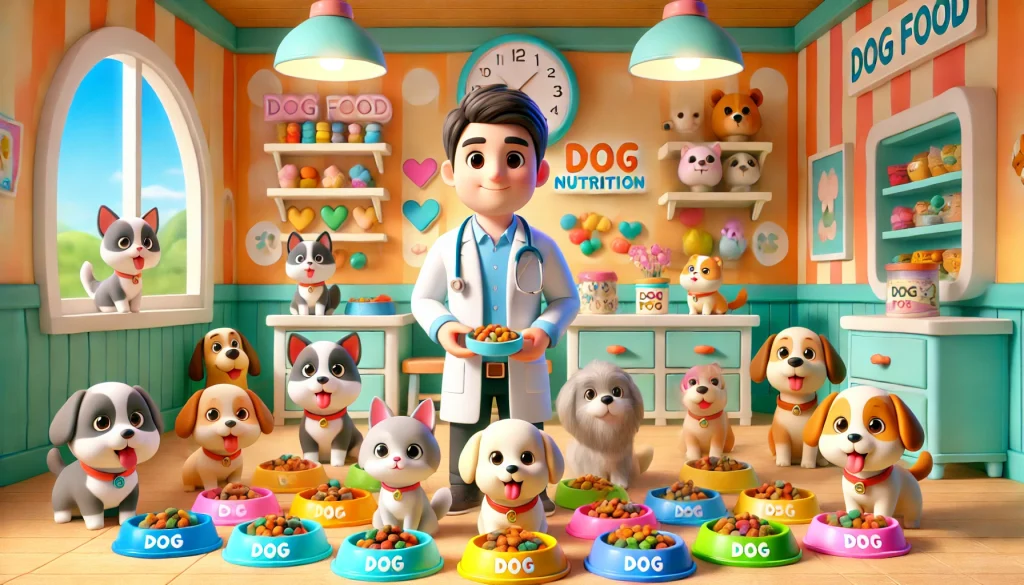Choosing the right diet for your canine companion is one of the most important decisions you can make as a pet owner. With so many options available, it can feel overwhelming to determine the best food for my dog. This comprehensive guide will walk you through everything you need to know about dog nutrition, from understanding nutritional requirements and ingredient labels to discovering expert tips and proven strategies for selecting a healthy diet. Whether you have a lively puppy, an active adult, or a senior dog with specific dietary needs, this article is packed with information to help you make the best choices for your furry friend.
In today’s fast-changing pet food market, new formulas and trends emerge all the time. Our goal is to provide you with an enjoyable and informative resource that combines scientific research with real-life insights. Along the way, you’ll find links to reputable sources like CarePetAI and PetMD that offer additional expert advice.
When it comes to choosing the best food for my dog, the decision goes far beyond simply picking a brand off the shelf. It involves understanding your dog’s unique needs, considering their breed, age, weight, activity level, and any specific health issues. By the end of this article, you’ll be empowered with the knowledge to tailor your dog’s diet to promote optimum health and longevity.
Let’s dive into the world of dog nutrition and explore how you can choose the best food that not only tastes great but also fuels your dog’s adventures and daily activities.
Understanding Your Dog’s Nutritional Needs
Every dog is unique, and their dietary requirements can vary widely depending on several factors such as age, breed, size, and activity level. Before you can choose the best food for my dog, it is important to understand what your dog needs to stay healthy.
Dogs require a balanced mix of proteins, fats, carbohydrates, vitamins, and minerals. Proteins, which come from meat, fish, or plant-based sources, are the building blocks for muscle growth and repair. Fats provide energy and support healthy skin and coat, while carbohydrates supply quick energy to fuel daily activities. Vitamins and minerals are essential for maintaining bodily functions and overall well-being.
For instance, a highly active breed like a Border Collie may require more calories and protein than a sedentary companion. Puppies and growing dogs have different nutritional demands compared to senior dogs who might benefit from diets designed to support joint health and manage weight. Understanding these differences is key to selecting the best food for my dog.
To learn more about the nutritional needs of your dog, check out additional resources on sites such as ASPCA’s Dog Nutrition Guide.
Key Ingredients to Look For
One of the first steps in identifying the best food for my dog is knowing what ingredients to look for. High-quality dog food should list a specific source of animal protein as the first ingredient. Look for terms like “chicken,” “beef,” or “salmon” rather than vague phrases such as “meat meal.”
Additionally, wholesome carbohydrate sources like brown rice, barley, or sweet potatoes can provide energy without causing rapid spikes in blood sugar. Healthy fats from sources like fish oil or flaxseed are important for supporting a shiny coat and healthy skin. When reading labels, steer clear of artificial preservatives, colors, and fillers that may not contribute to your dog’s overall health.
It is also essential to consider any potential food allergies or sensitivities your dog may have. Many dogs develop allergies to common ingredients like corn, wheat, or soy. In these cases, choosing a limited-ingredient or hypoallergenic formula may be the best food for my dog.
Decoding Nutritional Labels
Navigating the information on dog food labels can be daunting, but it’s an essential skill for any pet owner. The nutritional label provides a breakdown of the ingredients and their nutritional content. Here are a few tips to help you decode these labels:
- Protein Sources: Look for named meat sources (e.g., “chicken meal”) listed as the first ingredient.
- Carbohydrates: Choose complex carbohydrates such as brown rice or sweet potatoes for sustained energy.
- Fats: Identify healthy fats like fish oil, which provide essential omega fatty acids.
- Vitamins and Minerals: Ensure the food includes a balanced mix of vitamins and minerals for overall health.
Understanding these details can help you evaluate whether a product truly represents the best food for my dog or if it might contain unnecessary additives.
Comparing Dry, Wet, and Raw Diets
There is no one-size-fits-all answer when it comes to choosing the best food for my dog, as different feeding options suit different lifestyles and health needs. Here is a quick overview of the main types of dog food:
- Dry Food (Kibble): Dry food is popular for its convenience, long shelf life, and dental health benefits due to its crunchy texture. Many premium kibbles are formulated to provide balanced nutrition.
- Wet Food: Often higher in moisture content, wet food can be easier for some dogs to chew and digest. It may also be more palatable for picky eaters.
- Raw Diets: Raw feeding involves serving uncooked meat, bones, fruits, and vegetables. Advocates believe it mirrors a dog’s ancestral diet, though it requires careful preparation and adherence to strict hygiene standards.
Each of these options has its own benefits and drawbacks. The best food for my dog will depend on your dog’s individual needs, lifestyle, and even your own convenience and budget.
Expert Tips for Choosing the Best Food for Your Dog
With a deeper understanding of your dog’s nutritional needs and the key ingredients that matter, it’s time to explore practical advice for selecting the best food for my dog. Experts agree that informed choices can lead to better health, increased energy, and a happier pet.
Below are several expert tips that can guide you in making the right decision:
Consult Your Veterinarian: Your veterinarian is your best ally when it comes to determining the nutritional needs of your dog. They can provide recommendations based on your dog’s age, weight, activity level, and any health concerns. Regular check-ups ensure that any dietary changes are aligned with your dog’s overall health.
Do Your Research: The pet food market is filled with a wide range of products. Research customer reviews, seek recommendations from fellow pet owners, and visit reputable websites such as Pet Food Reviews to get insights into various brands.
Test Different Options: Every dog is different. It might take a little trial and error to find the best food for my dog that matches their taste and digestive needs. When switching foods, do so gradually to avoid upsetting your dog’s stomach.
Monitor Your Dog’s Health: Keep an eye on your dog’s coat, energy levels, and overall behavior after changing their diet. Improvements in these areas are strong indicators that you’ve chosen the right food.
Consider Specialized Diets: Some dogs have specific health needs, such as weight management, allergies, or sensitive digestion. In these cases, specialized formulas designed to address these issues may be the best food for my dog.
Creating a Balanced Meal Plan
Once you have selected a high-quality food, the next step is to ensure that your dog’s overall meal plan is balanced. This involves not only choosing the right food but also determining the correct portion sizes and feeding frequency. Overfeeding can lead to obesity, while underfeeding may result in nutrient deficiencies.
A balanced meal plan for your dog should take into account their daily energy expenditure and lifestyle. Active dogs that enjoy long walks or play sessions will require more calories than those with a more sedentary routine. Consult feeding guidelines on the dog food packaging, but also adjust portions based on your dog’s individual needs.
You might consider using a feeding schedule similar to the one below:
| Age/Size | Meal Frequency | Portion Size (Approx.) |
|---|---|---|
| Puppies | 3-4 meals/day | Varies by weight |
| Adult Small Dogs | 2 meals/day | 1/2 to 1 cup per meal |
| Adult Large Dogs | 2 meals/day | 1.5 to 3 cups per meal |
| Seniors | 2 meals/day | Adjusted for activity level |
Adjusting portions over time is essential, as your dog’s activity levels and metabolism may change with age. Regular weigh-ins and veterinary consultations can help fine-tune your dog’s meal plan, ensuring that you are consistently providing the best food for my dog.
Understanding the Role of Treats and Supplements
While choosing the right primary food is critical, don’t forget about treats and supplements. Treats can be a valuable tool in training and rewarding good behavior, but they should not replace a balanced diet. The key is moderation.
When selecting treats, look for those made with natural ingredients and avoid options with artificial additives. In some cases, supplements like omega fatty acids, glucosamine, or probiotics can complement your dog’s diet by supporting joint health, digestion, and coat condition. However, it’s important to consult with your veterinarian before introducing any supplements, as they can help determine whether your dog truly needs them.
Remember, the occasional treat should enhance your dog’s diet without contributing to excessive calorie intake. By striking a balance between meals, treats, and supplements, you are ensuring that your dog enjoys a complete nutritional profile—reinforcing your commitment to providing the best food for my dog.
Interactive Tools for Pet Nutrition
In today’s digital age, several interactive tools and mobile apps can help you track your dog’s nutritional intake and monitor their health. Many pet owners find these resources extremely useful in maintaining a balanced diet for their dogs.
Apps like CarePetAI not only offer digital nutritional calculators but also generate an AI-driven weekly nutritional plan customized specifically for your dog. Download the CarePetAI mobile app today to receive a personalized plan that adapts to your dog’s unique needs.
Additionally, some dog food brands offer online nutritional calculators that allow you to input your dog’s age, weight, and activity level to receive personalized feeding recommendations. Using these interactive features can help you adjust your dog’s diet in real time, keeping them healthy and happy.
Personalizing Your Dog’s Diet Through Home-Cooked Meals
For those who prefer to have greater control over ingredients, home-cooked meals for dogs are an excellent option. Preparing your dog’s food at home can ensure that every meal is tailored to their specific needs and free from artificial additives. However, home cooking requires careful planning to maintain a balanced nutritional profile.
If you decide to prepare meals at home, it is essential to consult with your veterinarian or a pet nutritionist. They can help you design recipes that incorporate the necessary proteins, carbohydrates, fats, vitamins, and minerals. A well-planned home-cooked meal can be as nutritious as commercial dog food and might even serve as the best food for my dog if done correctly.
There are many online communities and blogs dedicated to homemade dog food recipes. Websites like Dog Food Advisor and various pet care blogs offer recipes and tips for creating balanced meals at home. Experimenting with different recipes can be a fun and creative way to show your love and commitment to your dog’s well-being.
Real-Life Success Stories and Expert Insights
The journey to finding the best food for my dog is often filled with trial and error. Many pet owners have found success through careful observation and willingness to adjust their dog’s diet based on changing needs. Real-life success stories provide valuable insights and practical examples that can guide your own journey.
Consider the story of Sarah, a devoted pet owner who struggled to find a food that suited her energetic Labrador. After numerous consultations with her veterinarian and experimenting with several formulas, she discovered that a high-protein, grain-free diet dramatically improved her dog’s energy levels and coat condition. Sarah’s experience highlights the importance of persistence and customization when searching for the right food.
Similarly, expert insights from nutritionists emphasize that the best food for my dog is one that not only meets basic nutritional needs but also adapts to the dog’s life stage and health status. Whether it’s a recipe formulated for weight management, a special diet for sensitive digestion, or simply a premium dry food, the decision should always be rooted in comprehensive research and consultation.
For more inspiring success stories and professional advice, explore pet care forums on Reddit’s Dog Community or read articles on the AKC Expert Advice page.
Staying Up-to-Date with the Latest in Dog Nutrition
Dog nutrition is an evolving field, with new studies and innovations emerging all the time. Staying informed about the latest trends and research can help ensure that you continue to provide the best food for my dog. Subscribe to newsletters from reputable pet food companies, attend pet care seminars, and follow expert blogs to keep abreast of new findings.
Industry experts recommend that pet owners routinely review the ingredients and nutritional content of their dog’s food, as manufacturers frequently update formulas to incorporate new research. Keeping an open dialogue with your veterinarian about any dietary changes is also essential for long-term health.
As you explore new products and innovations, always cross-reference claims with reliable sources. Scientific journals, veterinary associations, and reputable pet care websites are excellent places to verify information. This diligence will ensure that your dog’s diet remains aligned with the most current nutritional standards.
The journey toward finding and maintaining the best food for my dog is ongoing. It is a commitment to continuous learning and adaptation—a commitment that ultimately contributes to the vitality and happiness of your beloved pet.
Practical Tips for Transitioning to a New Diet
Changing your dog’s diet, even when switching to a higher-quality food, should be done gradually. A sudden change can upset your dog’s digestive system, leading to stomach discomfort or diarrhea. To successfully transition to the best food for my dog, follow these practical tips:
- Mix Gradually: Start by mixing a small portion of the new food with the current food. Slowly increase the proportion of new food over a period of 7-10 days.
- Monitor Health: Keep an eye on your dog’s stool, energy levels, and overall behavior. Any signs of digestive upset should prompt a slower transition or consultation with your veterinarian.
- Stick to a Schedule: Consistency is key. Feed your dog at the same times each day and avoid sudden changes in feeding routines.
- Stay Patient: Every dog adjusts at its own pace. Give your pet time to acclimate to the new food, and don’t be discouraged by minor setbacks.
Transitioning gradually not only minimizes potential health issues but also helps you determine if the new diet is truly a good fit for your dog. Once your dog is fully adjusted, you should see improvements in their coat, energy, and overall vitality—clear signs that you have indeed chosen the best food for my dog.
Interactive Q&A Sessions and Community Support
One of the best ways to gain insights and validate your choices when selecting the best food for my dog is by engaging with other pet owners. Many online communities offer Q&A sessions, forums, and live chats where you can ask questions and share experiences. Platforms like Reddit and specialized Facebook groups are treasure troves of real-life advice.
These interactive sessions not only provide support but also help you stay updated with the latest trends and reviews. Sharing your experiences and asking for recommendations can significantly ease the process of selecting the right diet for your dog.
Consider joining local pet owner meetups or virtual webinars hosted by veterinary professionals. These events often include expert Q&A segments, where you can get personalized advice on transitioning to a new diet or adjusting your dog’s meal plan.
Tracking Your Dog’s Progress with Digital Tools
Finally, leveraging technology can be a game-changer when it comes to monitoring your dog’s nutrition and overall health. There are several digital tools available that allow you to track your dog’s weight, activity levels, and even their reaction to new diets. Many pet food companies now offer companion apps that help you keep detailed records of your dog’s health and nutritional intake.
Using these apps, you can set reminders for feeding times, log changes in behavior, and even share progress reports with your veterinarian. This data-driven approach not only supports your decision-making process but also ensures that you continue to provide the best food for my dog as their needs evolve over time.
For more details on innovative pet nutrition tools, visit CarePetAI where, in addition to digital tracking, you can download their mobile app to receive a generated AI weekly nutritional plan customized specifically for your dog's needs.
In conclusion, finding the best food for my dog is a journey that combines research, expert advice, and a deep understanding of your pet’s unique needs. By focusing on high-quality ingredients, understanding nutritional labels, and using interactive tools and community support, you can create a meal plan that ensures your dog enjoys a healthy, active, and happy life.
Whether you choose commercial dog food, opt for a raw diet, or decide to cook at home, the key is to remain informed and flexible. Regular veterinary check-ups, continuous learning, and a willingness to adapt your dog’s diet as they age will make all the difference in achieving long-term health and vitality.
Embrace the adventure of pet nutrition, knowing that every thoughtful choice you make is an investment in your dog’s well-being. With the right knowledge and resources at your fingertips, you’re well on your way to ensuring that your beloved companion receives the best food for my dog—fueling a life filled with energy, joy, and unconditional love.
We hope this guide has been both informative and enjoyable, providing you with a roadmap to navigate the complex world of dog nutrition. Continue exploring, asking questions, and sharing your experiences with fellow pet owners. The journey to optimal pet health is a shared one, and every insight brings you closer to giving your dog the vibrant, healthy life they deserve.
For more detailed advice and the latest updates on pet nutrition, subscribe to newsletters from top veterinary sites, join online pet care communities, and stay engaged with experts who can help you refine your dog’s diet. After all, providing the best food for my dog isn’t just about feeding—they’re about nurturing a bond that lasts a lifetime.
Here’s to many happy, healthy meals and a future filled with playful moments, energetic walks, and the unwavering companionship of your four-legged friend. Enjoy the journey and celebrate every milestone along the way!





